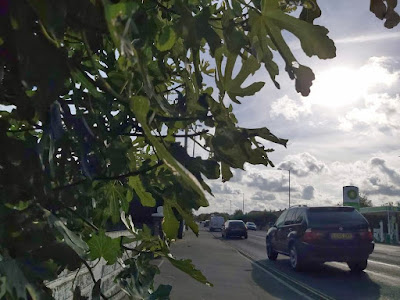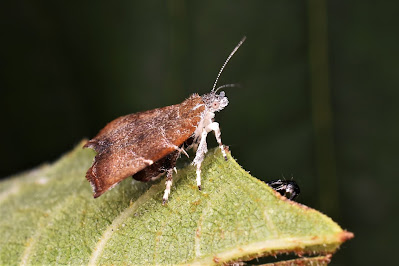Finding Choreutis nemorana
 |
| Fig-tree Skeletonizer - Choreutis nemorana |
News of this new moth reached me via a friend of mine with a particular interest in the early stages of moths. He told our group to look out for the tell-tale signs on Fig trees as "you never know". Shortly after, I found a potted Fig, around a metre tall, in the grounds of my children's school here in Lowestoft. It became a daily habit to idly look over the leaves of this tree, just in case some of these tiny moths decided to make the 130 mile journey from Hyde Park!
Years passed and, needless-to-say, I never found evidence of the moth on the school tree. As our boys progressed through school, I didn't see the potted Fig for months on end and thoughts of finding the moth were long-forgotten.
Fast forward to October 10th 2021. I met up with members of the Suffolk Moth Group for a leaf mine session in Lowestoft. I joked with the County Recorder that after a county first in 2019 and another in 2020 I was running out of time to find one this year. The very next day, Sarah and I were out walking when we happened to pass under an overhanging Fig tree which was growing in the gardens of an old house in Kirkley. Something caught my eye and I can only describe it as a 'light bulb moment"...
 |
| A 'moth eaten' Fig leaf |
A close inspection of the leaves revealed silken webs over the damaged parts of the leaf and after checking several leaves I found a larva. Having recently found the Apple-leaf Skeletonizer, Choreutis pariana on a local Apple tree I was pretty confident I'd found its Fig-munching cousin.
 |
| The First Caterpillar |
Sarah then spotted something different on a higher leaf; a neat curled leaf which looked like it might have something inside...
 |
| Rolled Leaf |
I later found out that Choreutis nemorana has an alternative common name, the Fig Leaf Roller. I bagged the leaf with the larva on and took a couple of rolled leaves to study at home later. I loaded up the Suffolk Moths website on my phone but couldn't find an entry for it. I tried the Norfolk Moths site but again, no entry. I realised that I might just have found myself another county first...
 |
| Extracted pupa |
 |
| The Caister Fig |
With the first records for both Suffolk and Norfolk within 5 days, all I could do now was wait for an adult to emerge so that I could make the finds public. Every day, myself and Jonathan exchanged messages but neither of us had an adult emerge until October 16th... I was out with the family on a shopping trip when my phone pinged with a message from Jonathan; "congratulations I'm a step-daddy" and the following photo:
 |
| Suffolk's first recorded adult Choreutis nemorana (J.Newman) |
With photo evidence of an adult I was able to put the news out on our Suffolk Moths WhatsApp group followed by the Suffolk and Norfolk moth groups on Facebook. Within a couple of hours of putting the news out, I was receiving reports of likely C.nemorana from up and down the East Anglian coast from Hollesley up to Winterton-on-Sea! When I got home from shopping a found that I too had an adult, this time from the Norfolk batch. Within a couple of days we had several adults between us and it was interesting to see how much variation there was between individuals. They were fascinating to watch; they scurried about on the leaves and only flew in short bursts from leaf to leaf. Their resting posture is similar to that of the Apple-leaf Skeletonizer, Choreutis pariana, with head down and bum up in the air!
 |
| White face and legs |
 |
| Scurrying about on the leaf |
So what about that small potted Fig in the school playground? I couldn't remember seeing it for moths if not longer. I had forgotten to look for it the previous week when picking up one of our mindees (we are childminders) so on October 20th I made a beeline to the corner of the playground where I last saw it. It took some finding as the potted tree had been moved next to a hedge where it was looking rather spindly. Surely these tiny moths couldn't have found such a pathetic specimen of a Fig? Well amazingly I was wrong... I found 3 Choreutis nemorana cocoons on it and the plant only had 7 leaves!






No comments:
Post a Comment